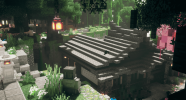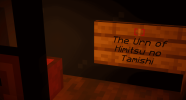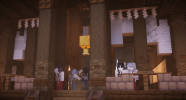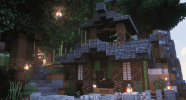
This document was worked on by @.Arkkwolf @KotaLobo @RexLobo @DarkEclipic and brought together by the entirety of the lore team. To every person who contributed to this work, a very special thank you! All credit goes to @RandomlyAccepted for the screenshots, and big thanks to @Oli for proof reading.
SYNOPSIS
The legacy of Karakura’s monastery is one wrapped up in devastation as a political pawn and an acting pillar of hope during the most difficult periods of the island’s history. For over a millennium, the monastery has stood, as it has warped with the changing times. Although it began as a Buddhist temple, the Shintoist influence of Japan forced a shift of dedication to the sacred grounds. Some of the most significant developments occurred from the two historic burnings that plagued the shrine. The first occurred due to the rebellion against Taira Kiyomori’s rule and the second was a product of outrage against Toyotomi Hideyoshi.
The monastery is not simply defined by such somber occurrences but is instead intertwined in history that reflects tradition and hope. Rituals and festivals composed by the shrine remained prominent even despite the Westernization of the modern era. Even during the destruction of the first and Second World War, the influence of the shrine remained intact, surging to unbelievable heights as many came to faith. Its connection to prominent figures within Karakura’s many eras cannot be overlooked. Itsbyoshi Families, especially that of Saiky, played key roles in furthering the monastery and upholding traditional Shintoist values. Many great shrine workers have come and gone as the centuries have passed, leaving a legacy that extends far beyond specific people. The monastery has become a reflection of Karakura’s resiliency, faced with war, suffering, and death, it stands as a traditional pillar of hope and faith.
Nara and Heian Periods (710-1192)
The beginning of Karakura’s monastery was one of humble origin. Despite the island being relatively untouched, several monks from the mainland seized the opportunity to stake claim to the area. Their main objective was to spread Buddhism to yet another corner of Japan. With the aid of several Karakuran settlers, in the year 744, they constructed a small place of prayer, dubbed the Saisho-Setchi Temple, within the Kohaku mountains. The location was chosen out of the belief that a manifestation of Buddha dwelled within its peaks. The small temple consisted of a path leading to the center of the mountain and a small shrine for prayer and offering. As Karakura grew in population, the monks gradually extended their influence to the island and its people.
 The sparse shrine was built into a sizable monastery by 976, due to unwavering public support. In celebration, the temple was given a new name befitting a great legacy, the Akatera Monastery. Along with the title, a tea house was constructed to promote visitation of the sacred space. Accompanying the development the first official religious festival within Karakura’s history was held. Many gathered in traditional attire, offerings in hand, to pay tribute. This was indeed a prosperous period for buddhism within Karakura.
The sparse shrine was built into a sizable monastery by 976, due to unwavering public support. In celebration, the temple was given a new name befitting a great legacy, the Akatera Monastery. Along with the title, a tea house was constructed to promote visitation of the sacred space. Accompanying the development the first official religious festival within Karakura’s history was held. Many gathered in traditional attire, offerings in hand, to pay tribute. This was indeed a prosperous period for buddhism within Karakura.Though, it seemed the Akatera Monastery’s pacifist nature wasn’t destined to last. It crumbled during the Japanese leadership change of 1159. Outrage was sparked across many Buddhist monasteries when a tradition of the previous Insei Government came to a halt, as Taira Kiyomori’s reign began. This tradition consisted of ruling bodies taking Buddhist vows before retiring to monastery grounds. Due to this, threats against such a rule surged throughout those who opposed. Subsequently, Kiyomori allies, who were infuriated by the rebellion burned the beloved Karakuran monastery to the ground. This marked the end of buddhism’s major influence on the island, as a new wide spread branch of the religion took its place, Shintoism. Alongside this shift, the once believed manifestation of Buddha, was reconized hence worth as a mountain kami, named Chiharu-Yamatsumi.
Kamakura Period (1192-1333)
This period of time was quiet, with only a handful of events happening for the monastery. In 1228, the Akatera Monastery was reconstructed, and once complete, it was renamed to the Kisune Monastery. This is where the religion shifted from Buddhist to Shinto. The newly reconstructed monastery grew its influence once more, and in 1232, it had enough power to rebel against the Hojo clan which controlled Japan. The major clans of Karakura fueled this rebellion, granting the Monastery more authority over the people. With the distance between the mainland and Karakura, and the strength of resistance, the island remained unaffected by the issues of the Hojo clan.
Muromachi Period (1338-1573)

As years went by, the Tsukasa family started to move their living space out into the mountains where they would use the area as their hunting grounds. This also enabled a more rural life in Karakura for those who decided to live that way. Though, before building the new grounds, the “Jin Chin Sai”, or the “Pacification of the Grounds” ritual is done to express respect and gratitude for the kami. Slowly, more religions started being introduced into Karakura through foreigners who started to take place there, one of the most popular ones being Christianity. Not minding them at first, the shrine didn’t think much about it until they had to start banishing Christian Missionaries from the shrine grounds due to harassing the shrine guests to convert.
Azuchi-Momoyama Period (1573-1603)
While the “Sword Hunt” began in 1588, Monastery workers started to bless the samurai who attempted to avoid the sword hunt by fleeing. While this went on, one of the few weapons that didn’t end up confiscated by the sword hunt was the shrine katana. This was used during Shinto funerals due to it being seen as a religious relic that held significance to the faith. Not long after, the Kisune Monastery was burnt down by Hideyoshi men who were faced with rebellion from not only citizens but from the clans as well. Several years later, it now being 1597, the Monastery workers started to get taken in my Nashima branches, Moritachi clans, and Saiky houses while they had no more home. This started to bring the two closer together than they were before, causing the ties between the two parties to further.
Edo Period (1603-1868)
After the burning of the Kitsune Monastery, the shrine went under major construction. Tearing down the burnt buildings, the construction workers stumbled across an Urn at the start of a cave that went into the mountain. Giving it to the Shrine Maidens and Priests as not to have a relic destroyed. The Maidens and Priests brought the Urn to the Hokuseibu Court, to see if they knew any information about the Urn. Upon examination of the Urn, there were only whispers and nothing written down. 'Himitsu no Tamishi' the Hokuseibu called it, or 'Urn of Secrets'. It is unknown who manufactured the urn or what secrets are sealed within. But one thing was sure to the court, there was a distrust of it.

The cave, which trailed under the Monastery, was littered with works of art along the stone walls. It told a story about the history of the monastery, giving an insight into the story of the land and those who have come before. It was sealed away only to be seen by the Itsbyoshi Court. During the years, after finding the cave and urn, the Monastery was finished. It was renamed 'Shinsei Seinaru Monastery' under the guidance of Kazuya Saiky, Saiky Houses, Nashima Branches, and Moritachi Clans. This showed a new chapter of the land before all chaos rained around them.
During the year 1622, the Ochiba Forest erupted in chaos and panic due to a large fire. This disrupted the delicate ecosystem that lived within the boundaries. However, amidst the turmoil, several Shrine Workers helped and led the Karakura Locals in rehabilitating the chaos that was the Ochiba Fire. It is uncertain who caused the fire to begin with, but fingers were being pointed towards a group of rogues, named Hōka-han Senshi, that was trying to create the second rise of the Kabukimono in Karakura. The Hōka-han Senshi were equipped with swords, smuggled in by the remnants of the Kabukimono. As time passed, the groups' power would eventually die out and fade into the history of Karakura.
Later that same year, there was a union between the Itsbyoshi and the Monastery with the union of Tsugumi Kaseya and Hachiro Takagi. This in turn strengthened the bond between the Clans and the Monastery on those hallowed grounds. These events not only shaped the Monastery's history but showed the resilience and dedication of Karakura during a period of Chaos and Change.
Meiji Period (1868-1912)
During this era, Karakura was resistant to Western influence, at least in the Itsbyoshi Court's eyes. The Townsfolk of Karakura seemed to be joyed by the freedom that the Imperial Rule had over the small island. The Courts, along with the Monastery, held peaceful protests throughout the small island to show their dislike of the Westernization of the deep-rooted culture and landscape they had built. It wasn't that they disliked the changing scene of Japan or even Karakura, but the court didn't like the idea that their foundation was crumbling. The Monastery became a symbol of resistance to the change, standing firm in the small world that was Karakura. Untouched by the mainland for way too long. As time went on, the Imperial Rule started to overpower their resistance, crumbling their protests and soon support.
Later in this period, during an unknown time, the Itsbyoshi Court was slowly disbanding, crumbling their perfect empire. The Resistance of the Imperial Rule was the shattering point, causing an eerie silence to wash over the monastery. This weakened the resistance, leaving the once vocal supporters without a voice in the ever-changing scene. This shift marked the turning point in the struggle that westernization caused in the once peaceful town, the shrine struggling even more without the presence of the Itsbyoshi Court. This reminded Karakura of the complex war between traditions and modernity in this period.
Taisho and Early Showa Period (1912-1945)
During this era, Karakura was wracked by war and suffering. The desperation of such a time led many to cling to their faith as a means to cope with the destruction. During the First World War, of the 30% of the population who were drafted, only 14% returned. The monastery was overwhelmed with citizen requests for prayers and support. This mass influx of death and the need for closure, caused the monastery to respond in a wide-reaching fashion. In the year 1919, a vigil was held on shrine grounds, organized by the monastery’s Kannushi, Shoken Miyazaki. Droves of grieving Karakurans gathered to release lanterns inscribed with messages to those they had lost. The monastery attempted to be a pillar during this catastrophic time, their influence led much of the remaining population to develop Shintoist beliefs.

The second war world only furthered the outcry and cemented the shrine as a support for those affected. In total three bombings occurred against the island, leading to vast amounts of injury and death. Replicating the previous response to the first war, another vigil was held in 1944. Its main focus was to honor the bombing victims and their families. It was not a substitute for funerals as the previous vigil had been, but instead a way to bring the community together in such a tragic time. Although much suffering came from this period, it also highlighted the strength of humanity and expanded the influence of the monastery exponentially.
Several Karakurans blamed the gods for their misfortune. Due to this, the monastery faced several attempts of defacing through targeted destruction of the grounds and profiling of monastery workers. It was simply one minor setback amongst the overwhelming public support of the shrine’s deeds. By the end of the era, most of the opposers had been warded off, allowing the staff to focus on spreading Shintoist ideals once more.
The Otori Corruption & Itsbyoshi Rise (1945-1964)
These periods were relatively peaceful for the Shinsei Seinaru Monastery. While the rapidly growing influence of the Otori family spread like wildfire within the city’s ranks, they neglected to make a mark on the monastery. Due to its seclusion in the mountains, they also were able to avoid the Financial Crime Wave during the late 40s. Rather, it was seen as a sanctuary for those who were affected by it, welcoming all who were suffering under the current regime. Housing those who lost their livelihoods, feeding those who were starving, and praying for the end of the era. This behavior solidified their standing in the community, bringing in more followers of Shintoism due to this, and strengthening the bonds with those who already practiced the religion.
Following the end of the corruption, in the year 1958, rumors floated all around the island. The forest surrounding the Itsbyoshi palaces were haunted, according to American explorers, with one of which going missing, and others returning with horror stories. This prompted the members of the shrine to attempt a cleansing of the area. However, the explorers claimed this had just enraged the spirits. Still, these rumors did not last, as the people of Karakura knew the truth behind the efforts of the shrine.
At the start of the next decade, three highschool students sought out the Guji of the monastery, Madoka Oyama. Oyama was a priest known for his powerful exorcisms. These students claimed to have discovered a haunted hut located within the mountains. However, there were no signs of a spirit which the priest could locate, leading to many ghost stories originating from that location.
The Education Boom & Westernization (1964-2006)

Once the Education Boom began, and the island of Karakura began to westernize, the influence of Shintoism began to dwindle. With more foreigners moving to the city, the natives began to adjust and stopped their frequent visits. The influence of christian missionaries spread, further limiting the shrine’s own influence. By the end of the 80s, only the families with devout followers of Shintoism frequented the monastery, where their children were educated in the ways of traditional Shintoism.
By the end of the 90s, a priest was driven insane by the lack of visits from the outside. In an attempt to get rid of the western ideals, they ignited the tarot card hut, believing it to be sacrilegious. However, this desperate attempt only drove people away from the monastery. This priest was removed from their position, and promptly arrested for the acts of arson toward the religious location.
Before the Storm & Modern Day (2006-2024)
The time following the Westernization Era was the quietest time within the extensive history of the monastery. Their popularity was still dropping, with only a handful of regular visitors up their mountain. Many of the rest were tourists or those curious to experience the traditional Japanese culture in their corner of the island. This however started to shift at the end of 2020, during october. Shrine popularity began to spike during the month, where citizens all claimed to experience paranormal activities. A practice which became common were cleansings, where shrine members performed either on individuals who were believed to be cursed, or structures which had been cursed to remove all bad omens and spirits.
The largest event in the Shrine’s history following these surges of popularity were the New Years festivals, where the western citizens embraced Japanese culture, wearing Kimonos to celebrate this day together. The monastery, without fail, always prepares lavish decorations, highlighting the culture in many ways.
During 2024, there was a major standoff between the Shrine and other factions of the island, mainly being the Police Department, the reporters, and Town Hall. The tension rose to the point where the shrine attempted to blacklist the entirety of the police department from the sacred grounds, but that was vetoed by the mayor, due to a lack of standing for such a blacklist. The relationship between the factions began to mend after these events. During a switch of leadership in the shrine, there was an accidental fire set in the teahouse, where a small part of the building was destroyed. Mitsue-Shiro Randamu Heddo took this as a sign to renovate the buildings to be more resistant to accidents. With some assistance from the mayor, the Shinsei Seinaru Monastery was raised to a more elegant state.
Last edited:
